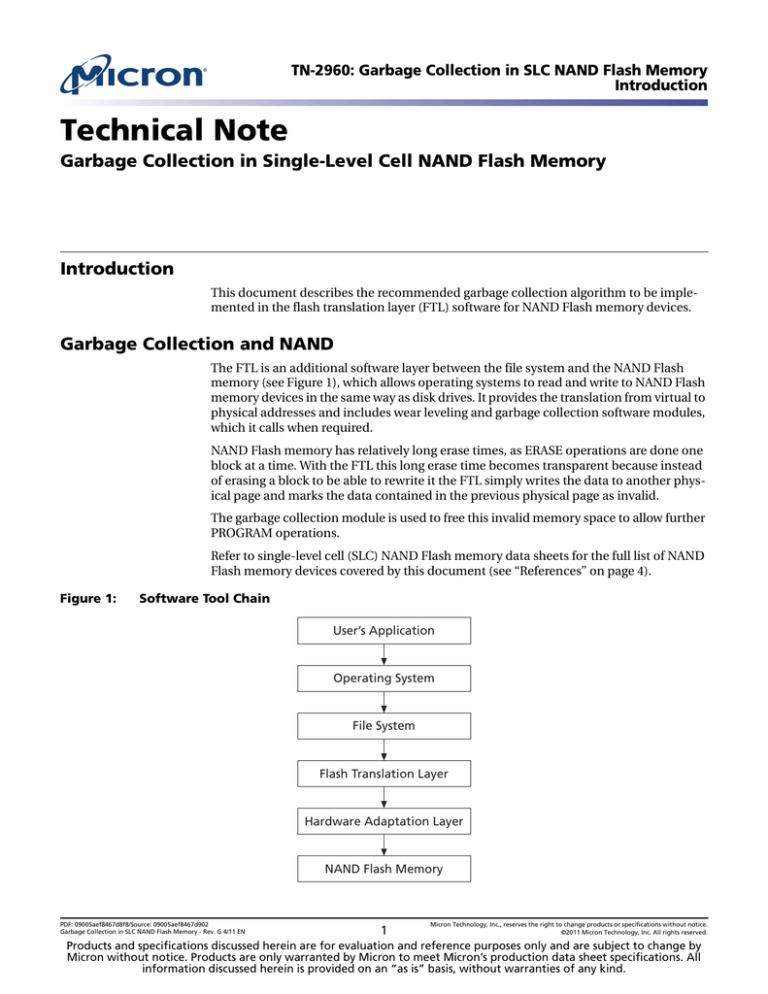
TN-2960: Garbage Collection in SLC NAND Flash Memory
Introduction
Technical Note
Garbage Collection in Single-Level Cell NAND Flash Memory
Introduction
This document describes the recommended garbage collection algorithm to be implemented in the flash translation layer (FTL) software for NAND Flash memory devices.
Garbage Collection and NAND
The FTL is an additional software layer between the file system and the NAND Flash
memory (see Figure 1), which allows operating systems to read and write to NAND Flash
memory devices in the same way as disk drives. It provides the translation from virtual to
physical addresses and includes wear leveling and garbage collection software modules,
which it calls when required.
NAND Flash memory has relatively long erase times, as ERASE operations are done one
block at a time. With the FTL this long erase time becomes transparent because instead
of erasing a block to be able to rewrite it the FTL simply writes the data to another physical page and marks the data contained in the previous physical page as invalid.
The garbage collection module is used to free this invalid memory space to allow further
PROGRAM operations.
Refer to single-level cell (SLC) NAND Flash memory data sheets for the full list of NAND
Flash memory devices covered by this document (see “References” on page 4).
Figure 1:
Software Tool Chain
User’s Application
Operating System
File System
Flash Translation Layer
Hardware Adaptation Layer
NAND Flash Memory
PDF: 09005aef8467d8f8/Source: 09005aef8467d902
Garbage Collection in SLC NAND Flash Memory - Rev. G 4/11 EN
1
Micron Technology, Inc., reserves the right to change products or specifications without notice.
©2011 Micron Technology, Inc. All rights reserved.
Products and specifications discussed herein are for evaluation and reference purposes only and are subject to change by
Micron without notice. Products are only warranted by Micron to meet Micron’s production data sheet specifications. All
information discussed herein is provided on an “as is” basis, without warranties of any kind.
TN-2960 Garbage Collection in SLC NAND Flash Memory
Garbage Collection
Garbage Collection
The garbage collection software copies the valid data into a new (free) area and erases
the original invalid data as illustrated in Figure 2
Garbage collection is performed when a virtual block is full or when the number of free
pages in the whole device is lower than a specified threshold value.
The basic operations involved in garbage collection are:
1. The virtual blocks meeting the conditions are selected for erasure.
2. The valid physical pages are copied into a free area.
3. The selected physical blocks are erased.
As virtual blocks can contain more than one physical block, the garbage collection may
erase more than one physical block.
Figure 2:
Garbage Collection Operation
Logical Unit Before
Garbage Collection
Logical Unit After
Garbage Collection
Page 0
Page 1
Page 1
Page 0
Page 0
Page 3
Page 2
Page 4
Page3
Page 2
Page 0
Invalid Page
Page 0
Valid Page
Free Page
Page 2
Page 4
Page 2
PDF: 09005aef8467d8f8/Source: 09005aef8467d902
tn2960_garbage_collection_slc_nand.fm - Rev. G 4/11 EN
2
Micron Technology, Inc., reserves the right to change products or specifications without notice.
©2011 Micron Technology, Inc. All rights reserved.
TN-2960 Garbage Collection in SLC NAND Flash Memory
FTL Performance
FTL Performance
The overall performance of the FTL directly depends on when and how free space is
maintained.
When the garbage collection software erases a virtual block so that it can be used again,
the garbage collection efficiency (Egc) for that block is defined as the ratio of the number
of invalid pages in the block to the total number of pages in the block. When all pages in
the block are garbage, Egc is 1:
number of invalid pages in Block
Egc = -------------------------------------------------------------------------------------total number of pages in Block
When the garbage collection efficiency for a block is low, a large number of pages must
be copied into other blocks before erasing the block. The greater the number of pages to
be copied the greater the number of WRITE operations to other blocks, which reduces
the lifetime of the NAND Flash device.
Another parameter for garbage collection performance is the amount of free area in the
device. Freeing enough memory space to accommodate data immediately when the
host requests it can improve the FTL’s sustainable throughput. Sustainable throughput is
the READ/WRITE throughput, taking into account the FTL software overhead.
In other words, when the number of data pages to be written exceeds the number of free
pages, the host must wait for the garbage collection software to erase all invalid blocks.
This can only be avoided by implementing garbage collection as frequently and rapidly
as possible by increasing the garbage collection rate at the expense of the garbage collection efficiency (Egc).
The FTL performance is determined by the trade-off between the garbage collection rate
and garbage collection efficiency.
Buffering can be used to improve garbage collection performance and reduce the
number of garbage collection operations at the same time.
PDF: 09005aef8467d8f8/Source: 09005aef8467d902
tn2960_garbage_collection_slc_nand.fm - Rev. G 4/11 EN
3
Micron Technology, Inc., reserves the right to change products or specifications without notice.
©2011 Micron Technology, Inc. All rights reserved.
TN-2960 Garbage Collection in SLC NAND Flash Memory
Background Feature
Background Feature
An FTL can implement a background feature that can be activated to optimize the
overall performance of the FTL. With this feature, the long erase times of NAND Flash
devices are transparent as the garbage collection is activated during the system’s idle
time. In this way, the FTL erases pages to free memory space automatically, and not only
when the number of data pages to be written exceeds the number of free pages.
When the FTL is not performing any READ or WRITE operations on the NAND Flash, the
power consumption will not be reduced if garbage collection is activated. Therefore, it is
not recommended to use garbage collection with the background feature activated in
systems where low power consumption is required.
References
The following documents related to NAND Flash memory are available on
www.micron.com:
• NANDxxx-A Single-Level Cell Small Page NAND Flash memory family data sheets
• NANDxxx-B Single-Level Cell Large Page NAND Flash memory family data sheets
• How to use the FTL and HAL software modules to manage data in Single Level Cell
NAND Flash memory
• Wear Leveling in Single-Level Cell NAND Flash Memory
• Error Correction Code in Single-Level Cell NAND Flash Memory
• Bad Block management in Single-Level Cell NAND Flash Memory
Conclusion
Implementing garbage collection in the FTL is recommended to free invalid memory
space to allow further PROGRAM operations. The overall performance of FTL is a tradeoff between garbage collection efficiency and garbage collection rate. Performance can
be improved by activating a background feature, which enables garbage collection
during the system’s idle time.
8000 S. Federal Way, P.O. Box 6, Boise, ID 83707-0006, Tel: 208-368-3900
www.micron.com/productsupport Customer Comment Line: 800-932-4992
Micron and the Micron logo are trademarks of Micron Technology, Inc. All other trademarks are the property of their respective owners.
PDF: 09005aef8467d8f8/Source: 09005aef8467d902
Garbage Collection in SLC NAND Flash Memory - Rev. G 4/11 EN
4
Micron Technology, Inc., reserves the right to change products or specifications without notice.
©2011 Micron Technology, Inc. All rights reserved.







